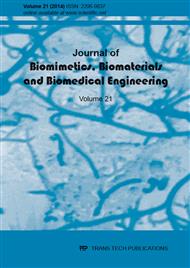[1]
E. Ooms, E. Egglezos, J. Wolke, and J. Jansen, Soft-tissue response to injectable calcium phosphate cements, Biomaterials 24 (2003) 749-757.
DOI: 10.1016/s0142-9612(02)00408-8
Google Scholar
[2]
Y. Zuo, F. Yang, J. G. Wolke, Y. Li, and J. A. Jansen, Incorporation of biodegradable electrospun fibers into calcium phosphate cement for bone regeneration, Acta Biomaterialia 6 (2010) 1238-1247.
DOI: 10.1016/j.actbio.2009.10.036
Google Scholar
[3]
M. Bohner, Calcium orthophosphates in medicine: from ceramics to calcium phosphate cements, Injury 31, Supplement 4 (2000) D37-D47.
DOI: 10.1016/s0020-1383(00)80022-4
Google Scholar
[4]
S. V. Dorozhkin, Calcium orthophosphate cements for biomedical application, Journal of Materials Science 43 (2008) 3028-3057.
DOI: 10.1007/s10853-008-2527-z
Google Scholar
[5]
G. Vereecke and J. Lemaître, Calculation of the solubility diagrams in the system Ca(OH)2-H3PO4-KOH-HNO3-CO2-H2O, Journal of Crystal Growth 104 (1990) 820-832.
DOI: 10.1016/0022-0248(90)90108-w
Google Scholar
[6]
A. Siddharthan, S. Seshadri, and T. Sampath Kumar, Rapid synthesis of calcium deficient hydroxyapatite nanoparticles by microwave irradiation, Trends Biomater Artif Organs 18 (2005) 110-113.
Google Scholar
[7]
Z. Yang, J. Han, J. Li, X. Li, Z. Li, and S. Li, Incorporation of methotrexate in calcium phosphate cement: behavior and release in vitro and in vivo, Orthopedics 32 (2009) 27.
DOI: 10.3928/01477447-20090101-28
Google Scholar
[8]
A. L. Ortiz, F. Sánchez-Bajo, N. P. Padture, F. L. Cumbrera, and F. Guiberteau, Quantitative polytype-composition analyses of SiC using X-ray diffraction: a critical comparison between the polymorphic and the Rietveld methods, Journal of the European Ceramic Society 21 (2001).
DOI: 10.1016/s0955-2219(00)00332-0
Google Scholar
[9]
G. Mestres, C. Le Van, and M. -P. Ginebra, Silicon-stabilized α-tricalcium phosphate and its use in a calcium phosphate cement: Characterization and cell response, Acta Biomaterialia 8 (2012) 1169-1179.
DOI: 10.1016/j.actbio.2011.11.021
Google Scholar
[10]
J. T. Zhang, F. Tancret, and J. M. Bouler, Fabrication and mechanical properties of calcium phosphate cements (CPC) for bone substitution, Materials Science and Engineering: C 31 (2011) 740-747.
DOI: 10.1016/j.msec.2010.10.014
Google Scholar
[11]
J. Lemaître, Mirtchi A., Mortier A., Calcium phosphate cements for medical use: state of art and perspectives of development, Silicates Industriels 9-10 (1987) 141-146.
Google Scholar
[12]
M. Bohner, H. P. Merkle, P. V. Landuyt, G. Trophardy, and J. Lemaitre, Effect of several additives and their admixtures on the physico-chemical properties of a calcium phosphate cement, Journal of Materials Science: Materials in Medicine 11 (2000).
DOI: 10.1023/a:1008997118576
Google Scholar
[13]
W. -C. Chen, J. -H. C. Lin, and C. -P. Ju, Transmission electron microscopic study on setting mechanism of tetracalcium phosphate/dicalcium phosphate anhydrous-based calcium phosphate cement, Journal of Biomedical Materials Research Part A 64A (2003).
DOI: 10.1002/jbm.a.10250
Google Scholar
[14]
M. -P. Ginebra, C. Canal, M. Espanol, D. Pastorino, and E. B. Montufar, Calcium phosphate cements as drug delivery materials, Advanced Drug Delivery Reviews 64 (2012) 1090-1110.
DOI: 10.1016/j.addr.2012.01.008
Google Scholar
[15]
L. Chow, Next generation calcium phosphate-based biomaterials, Dental Materials Journal 28 (2009) 1-10.
Google Scholar
[16]
E. Ferna´ndez, F. J. Gil, M. P. Ginebra, F. C. M. Driessens, J. A. Planell, and S. M. Best, Calcium phosphate bone cements for clinical applications. Part I: Solution chemistry, Journal of Materials Science: Materials in Medicine 10 (1999).
DOI: 10.1023/a:1008958112257
Google Scholar
[17]
E. Fernández, M. P. Ginebra, M. G. Boltong, F. C. M. Driessens, J. A. Planell, J. Ginebra, E. A. P. De Maeyer, and R. M. H. Verbeeck, Kinetic study of the setting reaction of a calcium phosphate bone cement, Journal of Biomedical Materials Research 32 (1996).
DOI: 10.1002/(sici)1097-4636(199611)32:3<367::aid-jbm9>3.0.co;2-q
Google Scholar
[18]
M. P. Ginebra, E. Fernández, E. A. P. De Maeyer, R. M. H. Verbeeck, M. G. Boltong, J. Ginebra, F. C. M. Driessens, and J. A. Planell, Setting Reaction and Hardening of an Apatitic Calcium Phosphate Cement, Journal of Dental Research 76 (1997).
DOI: 10.1177/00220345970760041201
Google Scholar
[19]
M. Espanol, R. A. Perez, E. B. Montufar, C. Marichal, A. Sacco, and M. P. Ginebra, Intrinsic porosity of calcium phosphate cements and its significance for drug delivery and tissue engineering applications, Acta Biomaterialia 5 (2009) 2752-2762.
DOI: 10.1016/j.actbio.2009.03.011
Google Scholar


